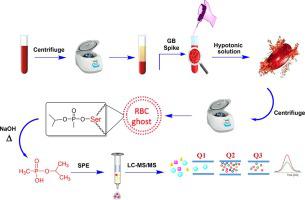当前位置:
X-MOL 学术
›
Microchem. J.
›
论文详情
Our official English website, www.x-mol.net, welcomes your feedback! (Note: you will need to create a separate account there.)
Verification of exposure to sarin nerve agent through the chemical analysis of red blood cell samples
Microchemical Journal ( IF 4.8 ) Pub Date : 2020-11-01 , DOI: 10.1016/j.microc.2020.105174 Fatemeh Mirbabaei , Ali Mohammad-Khah , Mehran Babri , Mohammad Taghi Naseri
Microchemical Journal ( IF 4.8 ) Pub Date : 2020-11-01 , DOI: 10.1016/j.microc.2020.105174 Fatemeh Mirbabaei , Ali Mohammad-Khah , Mehran Babri , Mohammad Taghi Naseri

|
Abstract Organophosphorus nerve agents (OPNAs) are an essential class of internationally banned chemical warfare agents that broadly target a family of enzymes known as serine hydrolases. In the body, OPNAs bind to butyrylcholinesterase (BChE), acetylcholinesterase (AChE), albumin and other proteins to form nerve agent adducts. These adducts can develop reliable, long-term protein biomarkers for human exposure to nerve agents. Red blood cells (RBC) are known targets of OPNAs toxicity effects. Since erythrocytes have a relatively long half-life, they may serve as a valuable tool for OPNA exposure verification. In the present report, a new, simple, and less expensive approach for detection of nerve agent exposure using alkaline hydrolysis of RBC membrane proteins, is evaluated. In this method, the hemoglobin-free ghost of human erythrocyte is prepared from 6 mL of sarin (GB) spiked RBC sample, and then treated with sodium hydroxide solution . In the presence of sodium hydroxide and elevated temperature, isopropyl methylphosphonic acid (IMPA) is released from RBC protein-sarin adducts. Two dimensional Solid-phase extraction (SPE) is employed for clean-up. The monitoring of IMPA using LC-MS/MS demonstrates that GB is added to RBC proteins. In the quantitative analysis of GB adducts, the calibration curve was found to be linear over a range of 10–100 µg L−1, and the limit of detection was 1 µg L−1. Our results indicate that membrane proteins of human erythrocyte could be exploited as a surrogate biomarker of nerve agent exposure.
中文翻译:

通过对红细胞样本的化学分析来验证沙林神经毒剂的暴露情况
摘要 有机磷神经毒剂 (OPNA) 是国际上禁止使用的一类必不可少的化学战剂,其广泛靶向被称为丝氨酸水解酶的酶家族。在体内,OPNA 与丁酰胆碱酯酶 (BChE)、乙酰胆碱酯酶 (AChE)、白蛋白和其他蛋白质结合,形成神经毒剂加合物。这些加合物可以为人类暴露于神经毒剂开发可靠的、长期的蛋白质生物标志物。红细胞 (RBC) 是 OPNAs 毒性作用的已知靶标。由于红细胞的半衰期相对较长,因此它们可以作为 OPNA 暴露验证的宝贵工具。在本报告中,评估了一种使用红细胞膜蛋白的碱性水解检测神经毒剂暴露的新的、简单且成本较低的方法。在这种方法中,人红细胞的无血红蛋白鬼影是从 6 mL 沙林 (GB) 加标的 RBC 样品中制备的,然后用氢氧化钠溶液处理。在氢氧化钠存在和升高的温度下,异丙基甲基膦酸 (IMPA) 从 RBC 蛋白-沙林加合物中释放出来。采用二维固相萃取 (SPE) 进行净化。使用 LC-MS/MS 监测 IMPA 表明 GB 已添加到 RBC 蛋白质中。在 GB 加合物的定量分析中,发现校准曲线在 10–100 µg L-1 范围内呈线性,检测限为 1 µg L-1。我们的结果表明,人类红细胞的膜蛋白可以用作神经毒剂暴露的替代生物标志物。在氢氧化钠存在和升高的温度下,异丙基甲基膦酸 (IMPA) 从 RBC 蛋白-沙林加合物中释放出来。采用二维固相萃取 (SPE) 进行净化。使用 LC-MS/MS 监测 IMPA 表明 GB 已添加到 RBC 蛋白质中。在 GB 加合物的定量分析中,发现校准曲线在 10–100 µg L-1 范围内呈线性,检测限为 1 µg L-1。我们的结果表明,人类红细胞的膜蛋白可以用作神经毒剂暴露的替代生物标志物。在氢氧化钠存在和升高的温度下,异丙基甲基膦酸 (IMPA) 从 RBC 蛋白-沙林加合物中释放出来。采用二维固相萃取 (SPE) 进行净化。使用 LC-MS/MS 监测 IMPA 表明 GB 已添加到 RBC 蛋白质中。在 GB 加合物的定量分析中,发现校准曲线在 10–100 µg L-1 范围内呈线性,检测限为 1 µg L-1。我们的结果表明,人类红细胞的膜蛋白可以用作神经毒剂暴露的替代生物标志物。使用 LC-MS/MS 监测 IMPA 表明 GB 已添加到 RBC 蛋白质中。在 GB 加合物的定量分析中,发现校准曲线在 10–100 µg L-1 范围内呈线性,检测限为 1 µg L-1。我们的结果表明,人类红细胞的膜蛋白可以用作神经毒剂暴露的替代生物标志物。使用 LC-MS/MS 监测 IMPA 表明 GB 已添加到 RBC 蛋白质中。在 GB 加合物的定量分析中,发现校准曲线在 10–100 µg L-1 范围内呈线性,检测限为 1 µg L-1。我们的结果表明,人类红细胞的膜蛋白可以用作神经毒剂暴露的替代生物标志物。
更新日期:2020-11-01
中文翻译:

通过对红细胞样本的化学分析来验证沙林神经毒剂的暴露情况
摘要 有机磷神经毒剂 (OPNA) 是国际上禁止使用的一类必不可少的化学战剂,其广泛靶向被称为丝氨酸水解酶的酶家族。在体内,OPNA 与丁酰胆碱酯酶 (BChE)、乙酰胆碱酯酶 (AChE)、白蛋白和其他蛋白质结合,形成神经毒剂加合物。这些加合物可以为人类暴露于神经毒剂开发可靠的、长期的蛋白质生物标志物。红细胞 (RBC) 是 OPNAs 毒性作用的已知靶标。由于红细胞的半衰期相对较长,因此它们可以作为 OPNA 暴露验证的宝贵工具。在本报告中,评估了一种使用红细胞膜蛋白的碱性水解检测神经毒剂暴露的新的、简单且成本较低的方法。在这种方法中,人红细胞的无血红蛋白鬼影是从 6 mL 沙林 (GB) 加标的 RBC 样品中制备的,然后用氢氧化钠溶液处理。在氢氧化钠存在和升高的温度下,异丙基甲基膦酸 (IMPA) 从 RBC 蛋白-沙林加合物中释放出来。采用二维固相萃取 (SPE) 进行净化。使用 LC-MS/MS 监测 IMPA 表明 GB 已添加到 RBC 蛋白质中。在 GB 加合物的定量分析中,发现校准曲线在 10–100 µg L-1 范围内呈线性,检测限为 1 µg L-1。我们的结果表明,人类红细胞的膜蛋白可以用作神经毒剂暴露的替代生物标志物。在氢氧化钠存在和升高的温度下,异丙基甲基膦酸 (IMPA) 从 RBC 蛋白-沙林加合物中释放出来。采用二维固相萃取 (SPE) 进行净化。使用 LC-MS/MS 监测 IMPA 表明 GB 已添加到 RBC 蛋白质中。在 GB 加合物的定量分析中,发现校准曲线在 10–100 µg L-1 范围内呈线性,检测限为 1 µg L-1。我们的结果表明,人类红细胞的膜蛋白可以用作神经毒剂暴露的替代生物标志物。在氢氧化钠存在和升高的温度下,异丙基甲基膦酸 (IMPA) 从 RBC 蛋白-沙林加合物中释放出来。采用二维固相萃取 (SPE) 进行净化。使用 LC-MS/MS 监测 IMPA 表明 GB 已添加到 RBC 蛋白质中。在 GB 加合物的定量分析中,发现校准曲线在 10–100 µg L-1 范围内呈线性,检测限为 1 µg L-1。我们的结果表明,人类红细胞的膜蛋白可以用作神经毒剂暴露的替代生物标志物。使用 LC-MS/MS 监测 IMPA 表明 GB 已添加到 RBC 蛋白质中。在 GB 加合物的定量分析中,发现校准曲线在 10–100 µg L-1 范围内呈线性,检测限为 1 µg L-1。我们的结果表明,人类红细胞的膜蛋白可以用作神经毒剂暴露的替代生物标志物。使用 LC-MS/MS 监测 IMPA 表明 GB 已添加到 RBC 蛋白质中。在 GB 加合物的定量分析中,发现校准曲线在 10–100 µg L-1 范围内呈线性,检测限为 1 µg L-1。我们的结果表明,人类红细胞的膜蛋白可以用作神经毒剂暴露的替代生物标志物。



























 京公网安备 11010802027423号
京公网安备 11010802027423号